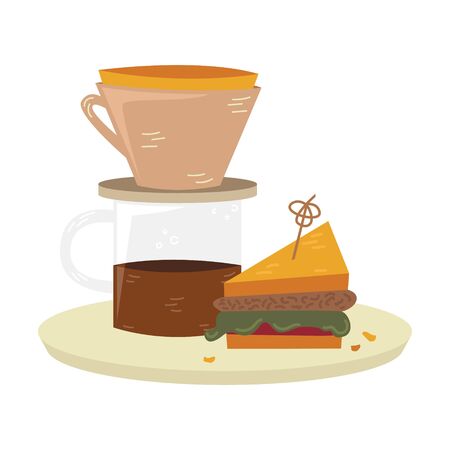1. Understand What Makes French Press Coffee Unique
Before diving into the best coffee beans for your French press, it’s important to understand what makes this brewing method stand out. The French press is known for producing a full-bodied, bold cup of coffee with a rich mouthfeel. Unlike drip machines or pour-over methods, the French press uses immersion brewing. This means the coffee grounds are fully steeped in hot water before being separated by a metal mesh filter. This process allows more of the coffees natural oils and fine particles to remain in your cup, giving you that signature robust flavor.
Why Bean Selection Matters
Because the French press doesn’t use a paper filter, it doesn’t strip away oils or fine sediments. That’s why choosing the right type of coffee bean can make a big difference. The flavors and textures of different beans will come through more strongly, so it helps to pick beans that complement this brewing style.
Main Characteristics of French Press Coffee
| Feature | Description |
|---|---|
| Flavor Profile | Full-bodied, bold, and often complex |
| Mouthfeel | Rich and heavy due to retained oils and fine grounds |
| Brew Method | Immersion (grounds steeped in water) |
| Filter Type | Metal mesh (no paper filter) |
| Brew Time | Around 4 minutes |
The Takeaway
If youre using a French press, youre already aiming for a deep, flavorful experience. The type of beans you choose will directly impact how that flavor comes through. So understanding what makes French press coffee unique is the first step toward choosing beans that bring out the best in every cup.
2. Choose the Right Roast Level
When it comes to brewing coffee with a French press, the roast level of your beans plays a big role in how your cup will taste. Different roast levels—light, medium, and dark—bring out different flavors and textures in the coffee. Understanding these differences can help you pick the perfect beans for your French press.
Understanding Roast Levels
Coffee beans go through various stages during roasting, which change their color, flavor, and aroma. Heres a simple breakdown of each roast level:
| Roast Level | Flavor Profile | Best For French Press? |
|---|---|---|
| Light Roast | Bright acidity, fruity or floral notes, lighter body | Not ideal — may taste too sharp or thin in a French press |
| Medium Roast | Balanced flavor, medium body, some sweetness and acidity | Great choice — brings out complex flavors without being overwhelming |
| Dark Roast | Bold, rich flavor with smoky or chocolatey notes, low acidity | Also a good choice — produces a strong and full-bodied cup |
Why Medium and Dark Roasts Work Best
The French press is known for creating a rich and full-bodied brew. Since it doesnt use a paper filter, more of the coffees natural oils make it into your cup. Medium and dark roasts tend to have more body and deeper flavors that shine through with this method. Light roasts, while great for pour-over or drip methods, can sometimes come off as too acidic or weak when brewed in a French press.
Quick Tip:
If youre just starting out with French press brewing, try using a medium roast from a single-origin source. It gives you clarity in flavor while still delivering that smooth texture the French press is known for.
In Summary:
For best results with your French press, go for medium or dark roasted beans. They complement the brewing style by enhancing body and flavor without over-extracting bitterness.

3. Look for Fresh, Coarsely Ground Beans
When it comes to brewing with a French press, the freshness of your coffee beans and the grind size are two of the most important factors. Unlike drip machines or espresso makers, the French press relies on immersion brewing, which means the coffee grounds sit in hot water for several minutes. This method brings out rich flavors—but only if you’re using the right kind of grind and fresh beans.
Why Coarse Grind Matters
The French press uses a metal mesh filter rather than a paper one, so if your coffee is ground too fine, it can slip through the filter and end up in your cup. A coarse grind keeps that from happening and allows for better flavor extraction without over-extraction or bitterness. Think chunky sea salt—that’s about the texture you want.
Grind Size Comparison
| Grind Size | Texture | Best For |
|---|---|---|
| Extra Fine | Powdery (like flour) | Turkish Coffee |
| Fine | Smooth (like table salt) | Espresso |
| Medium | Sandy (like beach sand) | Drip Coffee Makers |
| Coarse | Chunky (like sea salt) | French Press |
The Importance of Freshness
Coffee starts to lose its flavor shortly after its roasted—and even more quickly once its ground. That’s why freshly roasted beans are key for a bold, aromatic cup of French press coffee. Whenever possible, buy whole beans and grind them just before brewing. If youre buying pre-ground coffee, check the roast date on the packaging and aim to use it within two weeks of opening.
How to Spot Quality Ground Coffee
- Check the Roast Date: Look for a recent roast date—avoid coffee with no date at all.
- Avoid Pre-Ground Coffee Sitting on Shelves: Mass-produced ground coffee can be stale by the time it reaches you.
- Smell Test: Fresh coffee has a strong, pleasant aroma. If it smells dull or musty, skip it.
- Feel the Texture: If you’re buying from a local roaster or market, rub some between your fingers—it should feel rough and gritty like coarse sand.
- Airtight Packaging: Look for resealable bags with one-way valves that let gas escape without letting air in.
Selecting fresh, coarsely ground beans isnt just a detail—its what makes your French press brew truly shine. With the right texture and freshness, youll enjoy a richer, smoother cup every time.
4. Consider Bean Origin and Flavor Notes
When choosing coffee beans for your French press, one important factor to think about is where the beans come from. The origin of the bean has a big impact on its flavor. Different regions produce beans with unique taste profiles, and knowing what to expect can help you pick the right one for your personal preferences.
Why Origin Matters
Coffee beans absorb characteristics from their environment—things like climate, altitude, and soil all influence how a bean tastes. For example, beans grown in high altitudes tend to have brighter acidity, while those from lower altitudes may be more mellow or earthy.
Common Coffee Regions and Their Flavor Profiles
Here’s a quick guide to some popular coffee-growing regions and the typical flavors you might find in beans from each:
| Region | Flavor Notes | Best For |
|---|---|---|
| Africa (e.g., Ethiopia, Kenya) | Bright, fruity, floral | If you enjoy a light, vibrant cup with berry or citrus tones |
| Latin America (e.g., Colombia, Guatemala) | Balanced, nutty, chocolatey | If you like smooth, classic coffee flavors with mild acidity |
| Indonesia (e.g., Sumatra) | Earthy, bold, spicy | If you prefer a rich, full-bodied brew with low acidity |
Choosing Based on Your Taste Preferences
If youre just getting started with French press brewing, Latin American beans are often a safe bet because of their balanced flavor. But if youre feeling adventurous, try an Ethiopian roast for something bright and fruity—or go for a Sumatran bean if you want something deep and earthy.
Pro Tip:
Since the French press brings out the natural oils and body of the coffee, its a great brewing method to highlight the complexity of single-origin beans. Don’t be afraid to experiment until you find your favorite!
5. Buy Whole Beans and Grind at Home
If you want to get the best flavor out of your French press, buying whole beans and grinding them right before brewing is a game-changer. Pre-ground coffee loses its freshness quickly because once its ground, more surface area is exposed to air, light, and moisture. That means flavor and aroma start to fade fast — sometimes within just 15 minutes!
Why Freshly Ground Coffee Matters
Grinding your coffee beans at home lets you unlock their full potential. Whole beans keep their flavor sealed in until youre ready to brew. When you grind just what you need, right before making your coffee, youre getting the freshest taste possible — rich, bold, and complex.
The Right Grind Size for French Press
The French press method calls for a coarse grind. If the grind is too fine, it can slip through the mesh filter and make your coffee gritty. A proper coarse grind allows for full extraction without over-extracting or clogging up your press.
Grind Size Comparison
| Brew Method | Recommended Grind Size |
|---|---|
| French Press | Coarse (like sea salt) |
| Drip Coffee Maker | Medium (like sand) |
| Espresso Machine | Fine (like powdered sugar) |
Burr Grinder vs. Blade Grinder
If youre serious about your French press coffee, consider investing in a burr grinder instead of a blade grinder. Burr grinders crush the beans evenly between two surfaces, giving you a consistent grind size. That consistency is key for even extraction and a smooth cup.
Burr vs. Blade Grinder: What’s the Difference?
| Grinder Type | Main Benefit | Main Downside |
|---|---|---|
| Burr Grinder | Consistent grind size for better flavor | Tends to be more expensive |
| Blade Grinder | Affordable and easy to find | Inconsistent grind can affect taste |
A Small Step That Makes a Big Difference
You don’t need to be a barista to improve your French press game — just start with whole beans and grind them fresh with a burr grinder. It’s an easy upgrade that’ll bring out deeper flavors in every cup.


